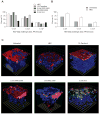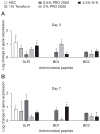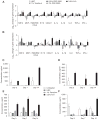Susceptibility to genital herpes as a biomarker predictive of increased HIV risk: expansion of a murine model of microbicide safety
- PMID: 20032541
- PMCID: PMC2879645
- DOI: 10.3851/IMP1463
Susceptibility to genital herpes as a biomarker predictive of increased HIV risk: expansion of a murine model of microbicide safety
Abstract
Background: A crucial gap in the development of microbicides for HIV prevention is the absence of models predictive of safety. Previous studies have demonstrated an increased susceptibility to genital herpes in mice following repeated applications of nonoxynol-9 (N-9). This study was designed to explore the underlying mechanisms, focusing on the effects that N-9 has on genital tract epithelium and to apply this expanded model to evaluate the safety of microbicides that have been advanced to clinical trials.
Methods: Mice were treated intravaginally with formulated 3.5% N-9, 1% tenofovir, 0.5% or 2% PRO 2000, hydroxyethylcellulose (HEC) placebo or no treatment and the effect on herpes simplex virus 2 (HSV-2) susceptibility, epithelial cell architecture, junctional proteins and inflammation were assessed.
Results: Mice treated with seven daily doses of N-9, but not tenofovir, PRO 2000 or HEC, were significantly more susceptible to challenge with low doses of HSV-2; confocal microscopy demonstrated increased numbers of viral particles deep within the genital tract. N-9 disrupted the epithelium with loss of tight and adherens junctional proteins. By contrast, the epithelium was relatively preserved following tenofovir, PRO 2000 and HEC exposure. Additionally, N-9, but not the other microbicides, triggered a significant inflammatory response relative to untreated mice.
Conclusions: These findings indicate that disruption of the epithelium contributes to increased HSV-2 susceptibility and might provide a biomarker predictive of increased risk for HIV acquisition. The results are consistent with the safety outcomes of the recently completed Phase IIb clinical trial with 0.5% PRO 2000 gel, and predict that tenofovir gel will not adversely affect the genital tract.
Conflict of interest statement
The authors declare no competing interests.
Figures






Similar articles
-
Vaginally delivered tenofovir disoproxil fumarate provides greater protection than tenofovir against genital herpes in a murine model of efficacy and safety.Antimicrob Agents Chemother. 2014;58(2):1153-60. doi: 10.1128/AAC.01818-13. Epub 2013 Dec 9. Antimicrob Agents Chemother. 2014. PMID: 24323471 Free PMC article.
-
Bridging the gap between preclinical and clinical microbicide trials: blind evaluation of candidate gels in murine models of efficacy and safety.PLoS One. 2011;6(11):e27675. doi: 10.1371/journal.pone.0027675. Epub 2011 Nov 11. PLoS One. 2011. PMID: 22096611 Free PMC article.
-
A comprehensive murine model to evaluate topical vaginal microbicides: mucosal inflammation and susceptibility to genital herpes as surrogate markers of safety.J Infect Dis. 2007 May 1;195(9):1332-9. doi: 10.1086/513279. Epub 2007 Mar 19. J Infect Dis. 2007. PMID: 17397004
-
Topical microbicides for preventing sexually transmitted infections.Cochrane Database Syst Rev. 2021 Mar 13;3(3):CD007961. doi: 10.1002/14651858.CD007961.pub3. Cochrane Database Syst Rev. 2021. PMID: 33719075 Free PMC article.
-
Drug delivery in multiple indication (multipurpose) prevention technologies: systems to prevent HIV-1 transmission and unintended pregnancies or HSV-2 transmission.Expert Opin Drug Deliv. 2012 Apr;9(4):417-27. doi: 10.1517/17425247.2012.668183. Epub 2012 Mar 2. Expert Opin Drug Deliv. 2012. PMID: 22385316 Review.
Cited by
-
Herpes simplex virus 2 infection: molecular association with HIV and novel microbicides to prevent disease.Med Microbiol Immunol. 2015 Apr;204(2):161-76. doi: 10.1007/s00430-014-0358-x. Epub 2014 Sep 11. Med Microbiol Immunol. 2015. PMID: 25209142 Free PMC article. Review.
-
Female genital tract secretions and semen impact the development of microbicides for the prevention of HIV and other sexually transmitted infections.Am J Reprod Immunol. 2011 Mar;65(3):325-33. doi: 10.1111/j.1600-0897.2010.00932.x. Epub 2010 Dec 12. Am J Reprod Immunol. 2011. PMID: 21143689 Free PMC article. Review.
-
Optimizing siRNA delivery to the genital mucosa.Discov Med. 2011 Feb;11(57):124-32. Discov Med. 2011. PMID: 21356167 Free PMC article. Review.
-
Topical prophylaxis for HIV prevention in women: becoming a reality.Curr HIV/AIDS Rep. 2011 Jun;8(2):104-13. doi: 10.1007/s11904-011-0075-7. Curr HIV/AIDS Rep. 2011. PMID: 21424725 Free PMC article.
-
Mucus-penetrating nanoparticles for vaginal drug delivery protect against herpes simplex virus.Sci Transl Med. 2012 Jun 13;4(138):138ra79. doi: 10.1126/scitranslmed.3003453. Sci Transl Med. 2012. PMID: 22700955 Free PMC article.
References
-
- Van Damme L, Chandeying V, Ramjee G, et al. Safety of multiple daily applications of COL-1492, a nonoxynol-9 vaginal gel, among female sex workers. AIDS. 2000;14:85–88. - PubMed
-
- Check E. Scientists rethink approach to HIV gels. Nature. 2007;446:12. - PubMed
-
- Cohen J. AIDS research. Promising AIDS vaccine’s failure leaves field reeling. Science. 2007;318:28–29. - PubMed
-
- HIV vaccine failure prompts Merck to halt trial. Nature. 2007;449:390. - PubMed
Publication types
MeSH terms
Substances
Grants and funding
LinkOut - more resources
Full Text Sources
Other Literature Sources
Medical
Miscellaneous

